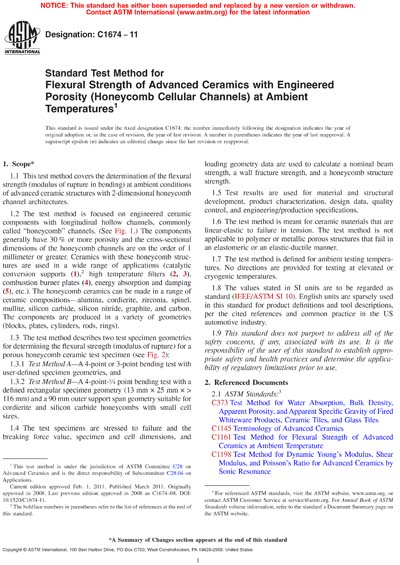Historical
ASTM C1674-11
Standard Test Method for Flexural Strength of Advanced Ceramics with Engineered Porosity (Honeycomb Cellular Channels) at Ambient Temperatures
1.1 This test method covers the determination of the flexural strength (modulus of rupture in bending) at ambient conditions of advanced ceramic structures with 2-dimensional honeycomb channel architectures.
1.2 The test method is focused on engineered ceramic components with longitudinal hollow channels, commonly called “honeycomb” channels. (See Fig. 1.) The components generally have 30 % or more porosity and the cross-sectional dimensions of the honeycomb channels are on the order of 1 millimeter or greater. Ceramics with these honeycomb structures are used in a wide range of applications (catalytic conversion supports (1), high temperature filters (2, 3), combustion burner plates (4), energy absorption and damping (5), etc.). The honeycomb ceramics can be made in a range of ceramic compositions
1.3 The test method describes two test specimen geometries for determining the flexural strength (modulus of rupture) for a porous honeycomb ceramic test specimen (see Fig. 2):
1.3.1 Test Method A—A 4-point or 3-point bending test with user-defined specimen geometries, and
1.3.2 Test Method B—A 4-point- ¼ point bending test with a defined rectangular specimen geometry (13 mm × 25 mm × > 116 mm) and a 90 mm outer support span geometry suitable for cordierite and silicon carbide honeycombs with small cell sizes.
1.4 The test specimens are stressed to failure and the breaking force value, specimen and cell dimensions, and loading geometry data are used to calculate a nominal beam strength, a wall fracture strength, and a honeycomb structure strength.
1.5 Test results are used for material and structural development, product characterization, design data, quality control, and engineering/production specifications.
1.6 The test method is meant for ceramic materials that are linear-elastic to failure in tension. The test method is not applicable to polymer or metallic porous structures that fail in an elastomeric or an elastic-ductile manner.
ASTM International [astm]

